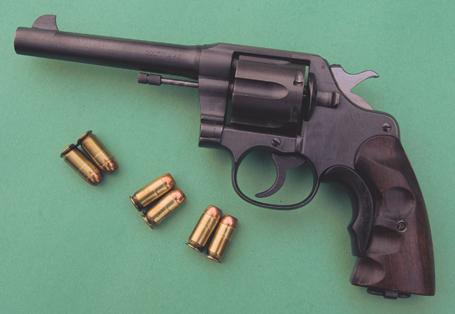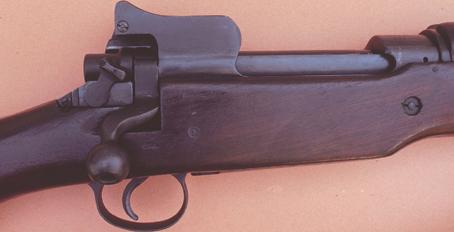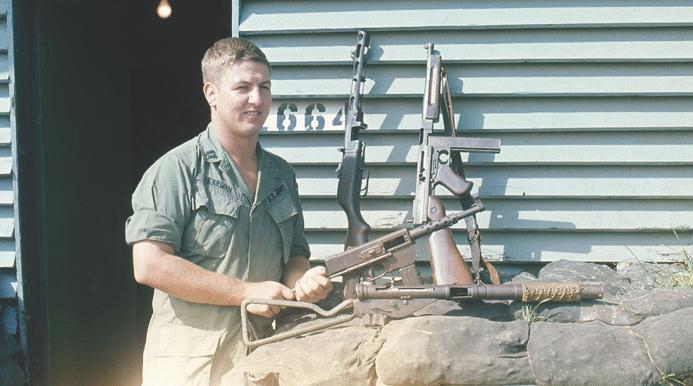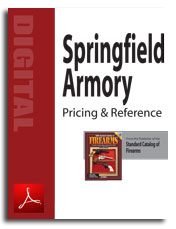 The M-1917 Colt 45 ACP revolver the author's late father purchased from the DCM in the early 1930's. Note the carving on the grips he did before WWII, and the grip adapter later added by the author. |
Since the U.S. government trusted its citizens with firearms in those days, the above-mentioned rifles and pistols were all made available for civilian purchase through the DCM, often at incredibly low prices. For example, brand new Russian M91 Mosin-Nagant rifles sold for as low as $3.24 with 7.625x4Rmm ammunition at $4.00 per thousand rounds. The Ross rifles went for about $5, with about the same amount for a thousand rounds of 303 ammo. Krag rifles went for as little as $1.50 and Trapdoor Springfield 45-70 rifles for only $1.25. The M-1917 30-06 rifle, the primary rifle used by U.S. forces in WWI and easily one of the very best military rifles of its day, could be bought for the grand sum of $7.50.
During this period, civilians could also purchase M-1903 Springfield rifles through the DCM in a wide variety of variations: used and new service rifles, service rifle? with star-gauge barrels, National Match variations, the NRA Sporter, Springfield M-1 and M-2 22 LR training rifles and many more model variations.
Between the world wars, all of the Mosin-Nagant, Ross, Krag, and Trapdoor Springfield rifles were sold off, either through the DCM or through surplus disposal channels. However, large quantities of M-1917 rifles, M-1903 rifles and M-1917 revolvers were still on hand when WWII broke out. These arms were quickly put back into U.S. military service, usually in a secondary role, or supplied to our allies. Over a million M-1917 rifles were sent to England, and they were also widely used by both our Chinese and Free French allies.
 The author's late father bought this Eddystone manufactured M-1917 rifle in the 1930s from the DCM for $7.50. It has repeatedly shot sub-MOA groups from the bench with match-grade ammunition. |
Shortly after WWII, the civilian marksmanship programs restarted. Again the DCM made large quantities of surplus rifles and handguns available to qualified buyers at bargain prices, including large quantities of M-1903A3 rifles introduced and produced during the war. Eventually, surplus M1 Garands and M-1 Carbines, as well as M-1911 and M-1911A1 pistols, were also made available.
After WWII, the M-1 Garand was eventually refined and accurized at Springfield Arsenal for use in service rifle competition. When the military teams began to win the National Service Rifle Matches with these match-grade M-1 Garands, civilian competitors clamored for match-grade M-1 rifles as well. Subsequently, new M-1 National Match rifles assembled at Springfield Arsenal were made available by the DCM for purchase by qualified civilian competitors. I still own my father's National Match M-1 that he purchased at the National Matches at Camp Perry, Ohio in 1960.
The same thing happened in the Service Pistol category with military shooters using arsenal-and custom-accurized M-1911A1 pistols. For a short period the DCM offered for sale to civilian shooters National Match M-1911A1 pistols that had been hand-assembled at Springfield Arsenal. However, the demand for such pistols was soon filled by the commercial firearms community and the sale of DCM National Match 45 pistols soon ended.
Unfortunately, the days of inexpensive surplus guns being available directly from the government at bargain prices were numbered. By the end of the '60s, anti-gun congressmen managed to close down DCM sales of firearms and remove much of the DCM's funding in spite of the fact that huge numbers of surplus guns were still in military stocks, and criminal use of such guns was virtually unknown. Incredibly, these anti-gun congressmen preferred to waste money destroying these guns rather than selling them to the very citizens that paid for them in the first place and who, in many cases, had risked their lives using them in service to their country. Unfortunately, during this period hundreds of thousands such guns were destroyed at considerable cost to the government, turning a substantial financial asset into a financial liability that subsequently poured precious tax dollars down the drain.
During this same period Congress commissioned a formal study of the DCM program by an independent firm to determine whether or not it justified its cost. Much to the chagrin of the anti-gun members of Congress, this study came back with findings that strongly supported the program.
The investigators found it an extremely cost-effective recruiting aid to get high-caliber American youth to enlist into the armed forces. It also reported that servicemen active in the DCM marksmanship programs prior to their service required less training to become proficient marksmen and were — as a group — better prepared for combat than recruits that had not been in the program. In other words, the original intention for the civilian marksmanship program was being accomplished and the existence of the program was completely validated. Needless to say, the anti-gun members of Congress totally ignored the findings of this study.
 A much younger and slimmer author in Vietnam displaying some captured submachine guns. The author credits his CMP training and experiences with interesting him in military service and, once he was on active duty, helping him do well. The weapons are a French 9mm MAT 49, a Chinese copy of the Soviet 7.622x5mm PPSh41, an M-1 Thompson, and a British 9mm Sten Mk IIS with integral noise suppressor. |
During those dark days, the DCM continued to support the National Matches, as well as many youth and club marksmanship programs. Eventually, it was able to get permission to sell some surplus M-1 Garand rifles to individuals, but the requirements for qualification to make a purchase were greatly increased. The person had to be over eighteen, a U.S. citizen, and a member of a DCM-affiliated club or association (formerly NRA membership was sufficient). They also had to show proof of recent participation in rifle competition, they could never have purchased an M-1 from the government before, and they had to submit to an FBI fingerprint check. At that time the cost of service-grade DCM M-1 Garand rifles was $94.30, but the price went up steadily over time.
The DCM programs continued to be attacked by anti-gun congressmen for decades and, eventually, their fiscal allocations for operation were completely lost. In 1996 Congress abolished the NBPRP. To save the CMP and the tremendous amount of good work it does, an innovative approach was taken by some clever members of Congress.
They wrote legislation that established the Corporation for the Promotion of Rifle Practice and Firearms Safety. This non-profit federally chartered corporation was given the responsibility for the supervision, oversight, and control of the U.S. Civilian Marksmanship Program. The law forming this corporation mandates that the mission of the CMP is the “Instruction of the citizens of the United States in marksmanship” with the highest priority going to training juniors. The CMP supplies firearms safety and marksmanship training through a nationwide network of affiliated shooting clubs, state shooting associations, and other organizations such as the Boy Scouts and school shooting teams.
To fund these activities the CMP is authorized to sell government surplus 22- and 30-caliber rifles, ammunition, repair parts, equipment and other related supplies. The proceeds from these sales are mandated to be spent to support the CMP programs. Indeed, the entire funding of the CMP operation is strictly from match entry fees and the sales of these items. Consequently, the near-giveaway prices of the old DCM days are, by necessity, gone.
Since this reorganization of the CMP, its leadership has taken a very wise long term approach to its funding. They place $100 from the sale of each M-1 rifle — and the entire proceeds of any special sales — into a “Permanent Investment Account.” The idea behind this is to accumulate enough funds in this account so that, by the time all the M-1 Garands on hand are sold off, the CMP will be able to continue operating for a long time afterward. Hopefully it will be able to run just off the interest on the account. In effect, the surplus stocks of M-1 Garand rifles are the CMP's cash cow. When they are gone the CMP does not want to go away as well.
For more information about the Civilian Marksmanship Program (CMP), Click Here
Are you in the market for an M1 Garand, Springfield 1903 or M1-A? Download the Standard Catalog of Firearms Springfield Armory Pricing & Checklist.
Format: PDF Download
Price: $2.99


![Best Concealed Carry Guns In 2025 [Field Tested] Wilson Combat EDC X9S 1](https://gundigest.com/wp-content/uploads/Wilson-Combat-EDC-X9S-1-324x160.jpg)


![Best 9mm Carbine: Affordable PCCs [Tested] Ruger Carbine Shooting](https://gundigest.com/wp-content/uploads/Ruger-Carbine-Shooting-100x70.jpg)
![Best AR-15: Top Options Available Today [Field Tested] Harrington and Richardson PSA XM177E2 feature](https://gundigest.com/wp-content/uploads/Harrington-and-Richardson-PSA-XM177E2-feature-100x70.jpg)

Great words from a truly great patriot and American! I grew up with “Chuck” in the 1950’s and only parted with him when my family moved away. My fondest memories are of all the firearm and gun stuff Chuck shared with us all. His Dad was a chemist and it rubbed off on Chuck: we’d take our Boy Scout knives to grade school, scrape the plaster walls in the gym for “niter,” use match heads for sulphur and beat up charcoal briquettes to make crude black powder! We were grade school kids! Later in life I would meet up with Chuck at regional and state wrestling matches–he usually won! I sure do miss him. Bet he’s showing St. Peter DCM skills in heaven! We love you, Brother!